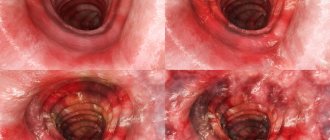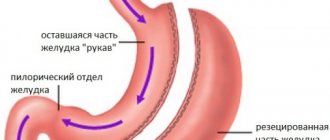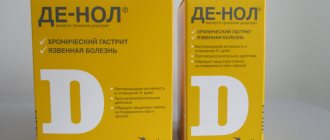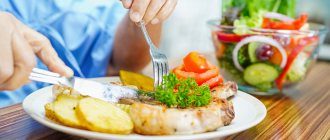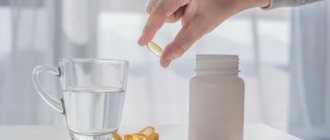In case of illness, nutritional therapy becomes the basis of corrective therapy. If you do not adjust your diet, drug treatment will not bring the desired result. This is why doctors always insist on following a certain diet. Practice shows that with timely changes in diet, remission occurs much faster, and the treatment itself becomes less long and serious.
Today, experts from the Wellness Consulting Academy will talk about nutrition for gastritis, give recommendations on the menu and a list of prohibited foods...
General rules. Duration of the diet.
The diet for chronic gastritis must be followed even in case of long-term remission. When eating for gastritis, you must adhere to certain rules:
- Meals should be at the same time.
- Meals should be fractional 5-6 times a day
- Dishes must be warm
- You can't overeat
- It is necessary to exclude foods that irritate the mucous membrane
- When eating, you must chew your food thoroughly
- You can't eat while running
- Last meal 2-3 hours before bedtime
- Separate meals and drinking water. You can drink it 30 minutes after eating.
Nutrition for gastritis during exacerbation:
In case of exacerbation of gastritis, it is necessary to start following a diet when the first symptoms of the disease appear. To get rid of pain and other unpleasant symptoms of the disease, you must strictly adhere to nutritional rules. The diet must be balanced in nutrients.
On the first day of exacerbation of gastritis, you must refrain from eating any food. Be sure to drink still water or herbal, non-hot teas. Products are introduced gradually as the symptoms of gastritis subside. It is necessary to follow the diet for several weeks, even if the symptoms of the disease have long disappeared.
Notice!
In case of exacerbation of the disease, sanatorium-resort treatment is contraindicated: it is better to go to a hospital.
If you have a chronic
form, then you should regularly
carry out preventive treatment
.
Nutrition after stroke
In her letter, the woman writes about a recent stroke, as well as chronic atrophic gastritis and underweight. Unfortunately, the author did not report what her weight was before the illness, when it dropped and by how much, what she eats, whether she follows a diet, what concomitant diseases caused the stroke, what medications she takes... This information would have made our conversation more substantive.
Post-stroke patients always face two tasks: to recover from a stroke and to prevent another. There is no special diet for such patients. Nutrition is adjusted individually taking into account blood pressure, the severity of atherosclerotic changes in blood vessels and the level of cholesterol in the blood, since it is often elevated in patients with chronic vascular diseases. In particular, for hypertensive patients, neurologists prescribe special drugs - statins - to reduce cholesterol and recommend limiting fat intake to 75-80 g per day, with half coming from vegetable oil.
I advise you to take these dietary features into account if your cholesterol levels are elevated. I also note that patients suffering from hypertension and having had a stroke are more likely to be overweight, which needs to be reduced. For the author of the letter, underweight is determined by one’s state of health.
Nutrition for chronic gastritis:
Diet for chronic gastritis should be varied and healthy. There should be no food on the table that irritates the gastric mucosa.
For chronic gastritis with high acidity, you must follow a very strict diet. It is very important to exclude from the diet foods that provoke the secretion of excess gastric juice. These are fried, spicy, salty foods, hard-to-digest foods, and an abundance of spices.
In case of chronic gastritis with low acidity, food should, on the contrary, stimulate the production of gastric juice. Preference should be given to semi-liquid and puree dishes. Small quantities of acidic foods (fermented milk, sour berries and fruits) are allowed.
Symptoms of gastritis
You can suspect gastritis based on the following symptoms:
- pain in the abdomen and stomach, cramping, stabbing;
- exacerbation of pain after eating, especially if the menu included spicy, fried, fatty foods in solid form;
- acute sudden pain or feeling of heaviness in the pit of the stomach;
- nausea and vomiting not associated with possible poisoning, intoxication or problems with the nervous system;
- frequent belching of air or eaten food;
- heartburn;
- unpleasant taste or odor from the mouth, unrelated to problems with teeth, tonsils, etc.;
- fatigue and decreased appetite.
Of course, you will not be diagnosed with gastritis based on symptoms alone, and a diet is also not prescribed solely based on your complaints. The doctor will conduct palpation, an in-person examination and then prescribe a gastroscopy, which will allow you to dot the i’s.
With early diagnosis and proper treatment (including with the help of prescribed therapeutic nutrition), you will be able to forget about unpleasant symptoms within 2 weeks. Although sometimes treatment is delayed up to 1.5 months.
Please note that after you stop taking medications, you should continue to eat a healthy diet - this will avoid relapses and exacerbations. If you start gastritis, then over time it can develop into a stomach ulcer or cause gastric bleeding. Some forms of chronic gastritis even lead to the development of stomach cancer. Therefore, you should not underestimate the seriousness of the diagnosis.
Types of diets:
There are different types of diets for gastritis
The diet depends on the type of disease (high/low acidity) and the course of gastritis (acute form or chronic form.
For gastritis with low acidity, it is recommended to stick to table No. 2, which includes juice products.
For gastritis with high acidity, diet No. 1 and its variations are recommended. In case of exacerbation, table 1A is prescribed for 7-10 days with a gradual transition to table 1 B.
Table No. 1A and 1B
Most often, during an exacerbation (the recommendation is relevant for not only chronic, but also erosive and reflux gastritis), gastroenterologists prescribe a diet according to table No. 1A and 1B. The main difference is the quality of processing of the products.
Table No. 1A is based on slimy soups and pureed porridges. All types of vegetables and bread are completely excluded from the menu. When transferred to table No. 1B, the diet expands due to the presence of pureed soups, vegetables and fruits pureed to a homogeneous consistency. The list of main products remains unchanged.
Important! Diet No. 1A is short-term and is prescribed during the first few days.
Table No. 1B includes the following products:
- Puree soups in vegetable broth, thickened with buckwheat, oatmeal, semolina or rice. Boiled vegetables are thoroughly ground and returned to the broth. Puree soups with the addition of boiled meat minced through a meat grinder. It is allowed to add a little cream, butter, and beaten egg to dishes.
- Homemade crackers made from wheat bread.
- Dietary meats - beef, veal, chicken. They are served to the table in the form of steam cutlets, zraz, meatballs, soufflé or quenelle.
- Fish – hake, pollock. Used for preparing steamed cutlets, meatballs, etc.
- Porridge – buckwheat, semolina, rice and oatmeal. The cereals are thoroughly boiled and additionally rubbed. You are allowed to add a little oil to the dish.
- Homogenized canned vegetables and fruits.
- Milk, cottage cheese soufflé and non-sour cottage cheese in their pure form.
- Eggs in the form of an omelet or cooked soft-boiled.
- Oil – butter and vegetable – for seasoning ready-made dishes.
- Sweet-tasting berries. Served in the format of jelly, mousse, jelly.
- Baked/stewed apples drizzled with honey.
During the day you need to drink at least 1.5 liters of liquid. Allowed for drinking are pure water, diluted juices - pumpkin and carrot juices are especially useful, bran decoction, tea with milk, and rosehip decoction. If we talk about what diet is prescribed to a patient with a combined exacerbation of an ulcer and gastritis of the stomach, then this is table No. 1A with a subsequent transition to table No. 1B.
The menu completely excludes or partially limits the following foods and dishes: fatty broths, fried/fatty/, smoked foods, marinades, fatty meats and fish, fresh vegetables and berries. Pasta, millet, barley, barley, corn grits, onions, and garlic are prohibited; legumes, sauces and mayonnaise, vinegar and carbonated drinks, strongly brewed teas, juices sour to taste, kvass.
List of permitted products:
| Cereals and porridges | Rice, oatmeal, buckwheat, semolina |
| vegetables | Zucchini, cauliflower, pumpkin, potatoes, carrots and beets |
| Dairy | Cream, milk, cottage cheese, butter |
| Meat | Beef, veal, rabbit, chicken, turkey, |
| Soft drinks | Apricot juice, carrot juice, pumpkin juice, rose hip decoction, dried fruit compote, mineral water |
Sit down at the table with an appetite
The following is true not only when a diet is used for atrophic gastritis, but in general. Dishes should be appetizing. Although older people may experience an attack of hunger, they still more often sit down to the dinner table without desire or pleasure. To improve your appetite, add some of your favorite spices, onions, garlic, and sour fruits to your food.
The diet should contain enough animal and plant proteins. Try to diversify your dishes - include various cereals, pasta, legumes, vegetables, and fruits in your weekly menu. Give preference to easily digestible foods - fish, poultry, eggs, dairy products.
Carbohydrates - day-old bread, cereals, dried fruits - as well as animal and vegetable fats correct body weight. Your menu includes butter, sour cream, cheese, vegetable oil (at least 1 tablespoon per day), nuts, seeds.
Don't forget about foods that are sources of vitamins. Let me remind you that vitamin C is contained in vegetables, fruits, berries, especially black currants, sea buckthorn and rose hips. Vitamins D and E - unrefined vegetable oil, egg yolk, liver. B vitamins – brown bread, nuts, whole grains, rice, peas, cabbage, milk, meat.
Patients with cardiovascular pathologies need foods rich in potassium and magnesium. Dried apricots, black currants, raisins, prunes, potatoes, green peas contain a lot of potassium, and bran, buckwheat, and beans contain a lot of magnesium. Sources of phosphorus, zinc, calcium, iron - cauliflower, cucumbers, walnuts, wheat, fish, liver, meat.
List of fully or partially restricted products:
| Vegetables | Cucumbers, pickled cucumbers, cabbage, sauerkraut, onions, legumes, spinach, sorrel, horseradish |
| Porridges and cereals | Corn, pearl barley, barley, millet cereals |
| Dessert | Ice cream, sweets, cakes, pastries |
| Dairy | Kefir, sour cream, yogurt |
| Meat products | Pork, ham, sausage, frankfurters, sausages, dried meat, smoked meat |
| Soft drinks | Tea, kvass, carbonated drinks, fruit drinks |
| Berries | Any berries, raw |
Restrictions
In order not to have too strong an effect on the stomach and its overwork, you should give up rye bread, puff pastry, as well as everything that already has a negative effect on the stomach: canned food, salty dishes, hot sauces and, especially, marinades. To this list you should add mushrooms, spinach, cucumbers, which are difficult to digest, onions, carbonated drinks, and black coffee.
To achieve results, you should adhere to a certain regimen and eat right: for breakfast you should eat milk rice porridge and tea with milk, and after a couple of hours have a snack of a baked apple with a little sugar. For lunch, prepare vegetable soup and steamed meat, and in the afternoon have a snack of crackers, washed down with rosehip decoction. Vegetable stew, baked fish and tea with milk are suitable for dinner. Before going to bed, it is advisable to drink milk, eat an apple or banana.
No one is immune from the risk of developing any disease. But everyone can prevent them. So, by adhering to certain rules, you can reduce this risk, minimize it and normalize your diet.
Recipes for dietary dishes for gastritis:
Nutrition for gastritis should be varied and nutritious. A properly formed menu allows you to provide the body with all the necessary nutrients.
Sample menu for the day:
Breakfast:
Milk buckwheat porridge with butter. Rose hip decoction.
Lunch:
Steam omelette. Baked sweet apple.
Dinner:
Vegetable soup with rice. Steamed chicken soufflé with mashed potatoes. Compote.
Afternoon snack:
Lazy dumplings. Kissel
Dinner:
Cod fillet with zucchini puree. Juice
Before bedtime:
Warm milk no more than 200 ml.
The importance of protein in gastrointestinal diseases
A weak body copes worse with “collecting” proteins from the diet, so it may lack this essential element.
Patients with gastrointestinal diseases are advised to pay attention to getting enough protein. In this case, dry protein mixtures help.
Diso Nutrimun is an easily digestible protein that can easily fit into the menu, will help damaged tissues and organs recover and will not force you to “get” the required amount of protein from foods that are not part of the diet.
Nutritionist comments:
Following a diet for gastritis allows you to achieve faster recovery and avoid possible relapses and complications.
“The right choice of a sanatorium is a significant step towards maintaining and increasing health. “Gorny” is a resort complex that combines the experience and knowledge of Russian and Soviet balneology. The presence of modern medical equipment and innovative installations, the professionalism of the staff and love for their work will serve as the key to extending longevity,” - head doctor of the sanatorium Alexander Olegovich Karaulov.
Is it possible to achieve a full recovery?
The question is controversial.
The opinions of experts are divided among those who believe that timely, modern complex treatment can contribute to recovery and complete restoration of the gastric mucosa. But there are those who do not think so, saying that it is practically impossible. That the process is irreversible from a certain stage, when most of the gastric mucosa has atrophied. If the disease is in the initial stage, then the prognosis is quite optimistic. Here, first of all, timely antibacterial therapy to eradicate H. pylori plays a positive role. New generation drugs and modern treatment regimens are characterized by good and lasting results.
